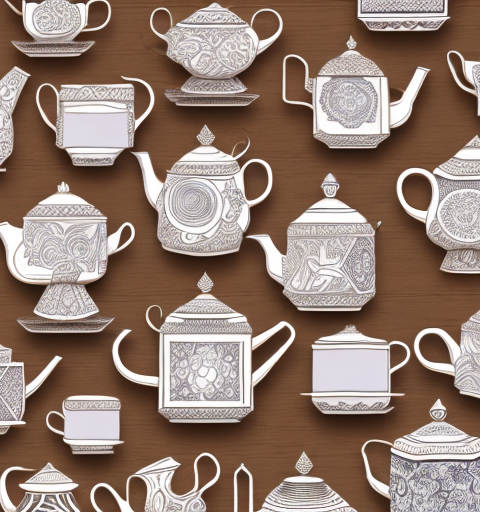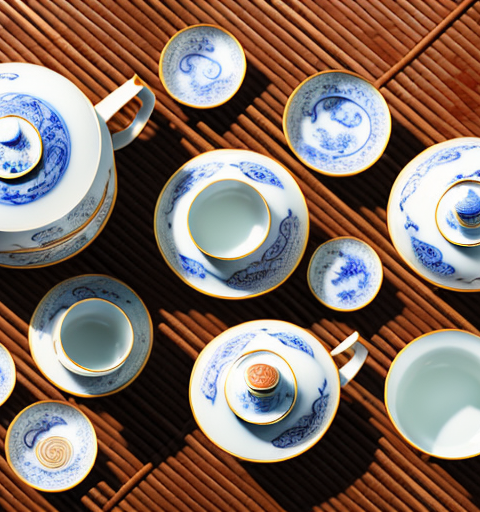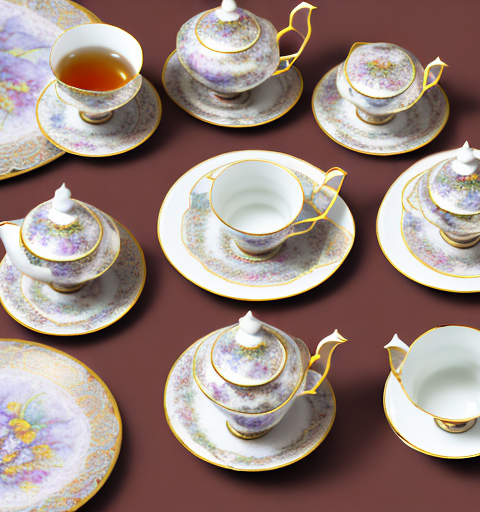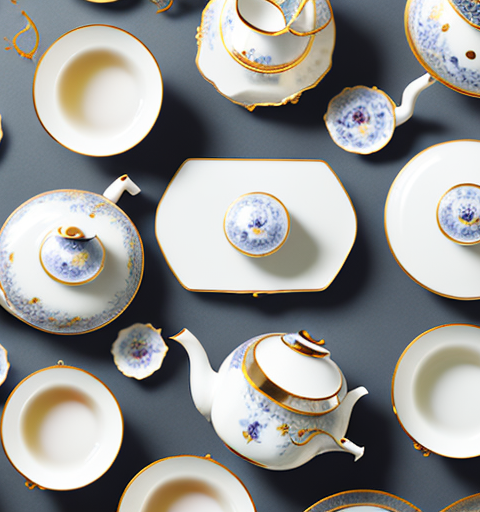Cleaning and maintaining a handcrafted ceramic teapot with a handcrafted finish is essential to preserve its beauty and functionality. Tea stains can be particularly stubborn, but with the right techniques and supplies, you can easily remove them and keep your teapot looking as good as new. In this article, we will delve into the importance of maintaining a clean teapot, the beauty of handcrafted ceramic teapots, and the various methods and natural remedies you can use to remove tea stains.
Understanding the Importance of Maintaining a Clean Teapot
Keeping your teapot clean is crucial for several reasons. First and foremost, a clean teapot ensures a better tasting brew. Tea stains can alter the flavor of your tea and affect the overall experience. Additionally, proper maintenance extends the lifespan of your teapot, allowing you to enjoy it for years to come. Regular cleaning also prevents the accumulation of germs and bacteria, promoting good health and hygiene.
Furthermore, a clean teapot is aesthetically pleasing. A stained or dirty teapot can be unappealing to look at, especially if you are serving tea to guests. By keeping your teapot clean, you can enhance the visual presentation of your tea and create a more enjoyable tea-drinking experience.
In addition, maintaining a clean teapot can prevent the transfer of flavors between different types of tea. If you use your teapot to brew different varieties of tea, residues from previous brews can mix with the new tea, altering its taste. By regularly cleaning your teapot, you can ensure that each cup of tea tastes as intended, without any unwanted flavors or aromas.
The Beauty of Handcrafted Ceramic Teapots
Handcrafted ceramic teapots are truly works of art. Each one is unique, with intricate designs and beautiful finishes that add an elegant touch to your tea-drinking experience. These teapots require special care to preserve their beauty and craftsmanship. Understanding the unique characteristics of handcrafted ceramic teapots will help you choose the right cleaning methods and avoid damaging their delicate exteriors.
One of the reasons why handcrafted ceramic teapots are so beautiful is the skill and artistry that goes into making them. Each teapot is carefully crafted by hand, with the artist paying close attention to every detail. From shaping the clay to adding intricate designs and patterns, the process of creating a handcrafted ceramic teapot is a labor of love.
Identifying Tea Stains on a Handcrafted Ceramic Teapot
Tea stains are not always visible to the naked eye, especially on a handcrafted ceramic teapot with a unique finish. However, over time, these stains can build up and become noticeable. To identify tea stains, inspect your teapot closely, paying attention to areas where tea frequently comes into contact with the surface. These may include the spout, handle, and inside of the teapot.
One method to identify tea stains on a handcrafted ceramic teapot is to gently run your finger along the surface. If you feel any rough or sticky areas, it is likely that there are tea stains present. Another way to detect tea stains is to shine a bright light onto the teapot and look for any discoloration or dark spots. Additionally, you can use a damp cloth or sponge to wipe the surface of the teapot. If the cloth or sponge becomes discolored, it is a sign of tea stains. Regular cleaning and maintenance can help prevent tea stains from becoming too noticeable on your handcrafted ceramic teapot.
Why Tea Stains Can Be Difficult to Remove from a Ceramic Teapot
Tea contains tannins, which can leave stubborn stains on ceramic surfaces. The porous nature of ceramic makes it susceptible to absorbing these stains, making them challenging to remove. Additionally, certain teas, such as black tea, can leave darker and more persistent stains. However, with the right cleaning techniques and supplies, you can effectively remove these stains and restore your teapot to its original shine.
One reason why tea stains can be difficult to remove from a ceramic teapot is the temperature at which the tea is brewed. Hot tea can cause the tannins to penetrate deeper into the ceramic, making the stains more stubborn. It is important to clean the teapot as soon as possible after use to prevent the stains from setting in. Additionally, the type of water used to brew the tea can also affect the staining. Hard water, which contains minerals, can leave behind deposits that contribute to the staining. Regular descaling of the teapot can help prevent these deposits and make stain removal easier.
Gather Your Cleaning Supplies: What You’ll Need to Remove Tea Stains
Before diving into the cleaning process, it’s essential to gather the necessary supplies. You’ll need mild dish soap, a soft sponge or cloth, baking soda, white vinegar, lemon juice, hydrogen peroxide, and warm water. These natural ingredients are effective in breaking down tea stains without causing any damage to the ceramic surface.
In addition to the cleaning supplies mentioned above, it’s also helpful to have a toothbrush or small brush with soft bristles. This can be used to gently scrub the tea stains and reach into any crevices or hard-to-reach areas. The soft bristles will ensure that the ceramic surface is not scratched or damaged during the cleaning process.
Step-by-Step Guide: Removing Tea Stains from a Handcrafted Ceramic Teapot
Follow these step-by-step instructions to remove tea stains from your handcrafted ceramic teapot:
- Fill the teapot with warm water and add a few drops of mild dish soap.
- Gently scrub the stained areas with a soft sponge or cloth, paying extra attention to the spots where the stains are most apparent.
- Rinse the teapot thoroughly with warm water to remove any soap residue.
- If tea stains persist, create a paste using baking soda and water. Apply the paste to the stained areas, scrub gently, and rinse thoroughly.
- For particularly stubborn stains, you can make a solution of equal parts white vinegar and warm water. Soak the stained areas for a few minutes, then scrub gently and rinse thoroughly.
- Another effective natural remedy is lemon juice. Squeeze fresh lemon juice onto the stained areas, let it sit for a few minutes, scrub gently, and rinse.
- If all else fails, hydrogen peroxide can be used as a last resort. Soak the stained areas with hydrogen peroxide, let it sit for a few minutes, scrub gently, and rinse thoroughly.
It is important to note that when using any cleaning solution or remedy on your handcrafted ceramic teapot, you should always test it on a small, inconspicuous area first to ensure that it does not cause any damage or discoloration. Additionally, avoid using abrasive materials or harsh chemicals, as they can scratch or damage the surface of the teapot. Always handle your handcrafted ceramic teapot with care and follow the manufacturer’s instructions for cleaning and maintenance to ensure its longevity and beauty.
Natural Remedies for Removing Tea Stains from Ceramic Teapots
Besides the methods mentioned above, there are other natural remedies you can try to remove tea stains from your ceramic teapot. These include using a paste made from baking soda and hydrogen peroxide or trying a mixture of white vinegar and salt. These natural alternatives are gentle yet effective in breaking down tea stains and restoring the shine of your teapot.
Another natural remedy you can try is using lemon juice. Lemon juice contains citric acid, which can help break down tea stains. Simply squeeze some fresh lemon juice onto a sponge or cloth and gently scrub the stained areas of your teapot. Rinse thoroughly with water afterwards to remove any residue.
If you prefer a more hands-off approach, you can also try using denture cleaning tablets. These tablets are designed to remove stains and buildup from dentures, but they can also be effective in removing tea stains from ceramic teapots. Simply dissolve a denture cleaning tablet in warm water and soak your teapot in the solution for a few hours or overnight. Rinse thoroughly afterwards to remove any residue.
Using Vinegar and Baking Soda to Remove Tea Stains from a Handcrafted Ceramic Teapot
Vinegar and baking soda are powerful natural cleaners that can work wonders on tea stains. To use this method, create a paste by mixing baking soda and white vinegar. Apply the paste to the stained areas, let it sit for a few minutes, scrub gently, and rinse thoroughly. Repeat the process if necessary until the stains are completely removed. This method is safe for handcrafted ceramic teapots and does not cause any damage to the finish.
One of the benefits of using vinegar and baking soda to remove tea stains is that they are readily available and affordable household items. You don’t need to purchase expensive cleaning products to achieve effective results. Additionally, both vinegar and baking soda are non-toxic and environmentally friendly, making them a great choice for those who prefer natural cleaning solutions.
It’s important to note that while vinegar and baking soda can be effective in removing tea stains, they may not work on all types of stains or on heavily stained teapots. In such cases, it may be necessary to seek professional cleaning services or try alternative methods. It’s always a good idea to test the cleaning solution on a small, inconspicuous area of the teapot before applying it to the entire surface to ensure compatibility with the material.
Lemon Juice: A Powerful Solution for Stubborn Tea Stains on Ceramic Teapots
Lemon juice is a natural acid that can effectively break down stubborn tea stains. Simply squeeze fresh lemon juice onto the stained areas, let it sit for a few minutes to allow the acid to work its magic, scrub gently, and rinse thoroughly. Lemon juice not only removes stains but also leaves a fresh citrus scent, making your teapot even more enjoyable to use.
In addition to its stain-removing properties, lemon juice also has antibacterial properties that can help sanitize your teapot. The acidic nature of lemon juice creates an environment that is inhospitable to bacteria, helping to keep your teapot clean and hygienic.
Furthermore, lemon juice is a natural and eco-friendly alternative to harsh chemical cleaners. By using lemon juice to remove tea stains from your ceramic teapot, you can avoid exposing yourself and the environment to potentially harmful chemicals found in commercial cleaning products.
The Benefits of Using Hydrogen Peroxide to Remove Tea Stains from Your Teapot
Hydrogen peroxide is a powerful stain remover that can be used as a last resort for persistent tea stains. Soak the stained areas with hydrogen peroxide, let it sit for a few minutes, scrub gently, and rinse thoroughly. It’s important to note that hydrogen peroxide may have a bleaching effect on certain ceramic finishes, so it’s advisable to test it on a small inconspicuous area before applying it to the entire teapot.
Another benefit of using hydrogen peroxide to remove tea stains from your teapot is that it is a natural and non-toxic alternative to harsh chemical cleaners. Unlike some commercial cleaning products, hydrogen peroxide does not contain harmful chemicals that can be harmful to your health or the environment.
In addition, hydrogen peroxide is readily available and affordable. You can easily find it at your local grocery store or pharmacy, and it is usually much cheaper than specialized teapot cleaners. This makes it a convenient and cost-effective option for removing tea stains from your teapot.
How to Safely Clean the Exterior of a Handcrafted Ceramic Teapot without Damaging the Finish
Cleaning the exterior of a handcrafted ceramic teapot requires careful attention to avoid damaging the finish. To safely clean the exterior, use a soft cloth or sponge dampened with warm water and mild dish soap. Gently wipe the surface, being cautious not to apply excessive pressure. Avoid using abrasive cleaners or scrub brushes, as they can scratch or dull the finish of your teapot.
After cleaning the teapot, rinse it thoroughly with clean water to remove any soap residue. Soap residue left on the surface can attract dirt and make the teapot appear dull. Make sure to rinse all areas, including the handle and spout, to ensure a thorough cleaning.
If there are stubborn stains or residue on the teapot that cannot be removed with mild dish soap, you can try using a paste made of baking soda and water. Apply the paste to the stained area and gently scrub with a soft cloth or sponge. Rinse thoroughly after scrubbing to remove any residue. However, be cautious when using baking soda, as it can be abrasive and may damage delicate finishes. Test the paste on a small, inconspicuous area of the teapot first to ensure it does not cause any damage.
Precautions to Take When Cleaning a Handcrafted Ceramic Teapot with a Delicate Finish
If your handcrafted ceramic teapot has a delicate finish, extra precautions should be taken during the cleaning process. Avoid using harsh chemicals, abrasive materials, or high-pressure water, as these can damage the delicate finish. Instead, opt for gentle cleaning methods using mild dish soap, soft sponges or cloths, and natural remedies such as baking soda and white vinegar. Always test any cleaning products on a small inconspicuous area before applying them to the entire teapot.
Tips for Preventing Tea Stains on Your Ceramic Teapots
Prevention is key when it comes to tea stains. Here are a few tips to help you prevent tea stains on your ceramic teapots:
- Regularly rinse your teapot with warm water after each use to remove any tea residue.
- Avoid leaving tea in your teapot for extended periods, as this can lead to more significant staining.
- Consider using a tea filter or strainer when brewing tea to minimize direct contact between the leaves and the teapot’s surface.
- Store your teapot in a clean and dry environment to prevent the accumulation of moisture, which can contribute to staining.
How Often Should You Clean Your Handcrafted Ceramic Teapot?
The frequency of cleaning your handcrafted ceramic teapot depends on how frequently it is used. As a general guideline, it is recommended to clean your teapot after each use, especially if tea stains are apparent. Regular maintenance and cleaning will help prevent tea stains from becoming deeply ingrained and more difficult to remove in the future.
Troubleshooting: What to Do When Tea Stains Persist on Your Ceramic Teapot
If tea stains persist despite your best efforts, it may be time to seek professional help. Ceramic restoration experts have specialized knowledge and tools to effectively remove stubborn stains without causing any further damage to your teapot. Contacting a professional can provide a solution when all other methods have been exhausted.
Alternative Methods for Removing Tea Stains from Handcrafted Ceramic Teapots
In addition to the natural remedies mentioned earlier, there are alternative methods you can try to remove tea stains from your handcrafted ceramic teapot. These include using denture cleaning tablets, white toothpaste, or even a mixture of lemon and salt. Experiment with these methods while being mindful of your teapot’s delicate finish, and choose the method that works best for you.
Expert Advice: Professional Tips for Cleaning and Maintaining Your Handcrafted Ceramic teapot with a Handcrafted Finish
To complement the information discussed in this article, we reached out to ceramic experts for their professional tips on cleaning and maintaining handcrafted ceramic teapots. Here are some valuable insights they shared:
- Never use harsh chemicals or abrasive materials on handcrafted ceramic teapots, as they can damage the finish.
- Regularly inspect your teapot for any signs of damage or wear and address them promptly.
- Store your teapot in a clean and dry area away from direct sunlight to prevent fading or discoloration.
- Consider using a teapot cozy or tea cozy to protect your teapot and maintain its temperature while serving.
By following these expert tips and taking the necessary precautions, you can ensure the longevity and pristine appearance of your handcrafted ceramic teapot with a handcrafted finish.






